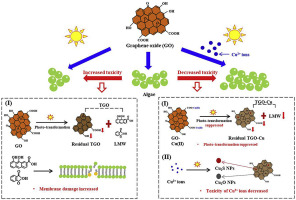当前位置:
X-MOL 学术
›
Water Res.
›
论文详情
Our official English website, www.x-mol.net, welcomes your
feedback! (Note: you will need to create a separate account there.)
Photo-transformation of graphene oxide in the presence of co-existing metal ions regulated its toxicity to freshwater algae.
Water Research ( IF 11.4 ) Pub Date : 2020-03-20 , DOI: 10.1016/j.watres.2020.115735 Jian Zhao 1 , Fangyuan Ning 2 , Xuesong Cao 3 , Huan Yao 2 , Zhenyu Wang 3 , Baoshan Xing 4
Water Research ( IF 11.4 ) Pub Date : 2020-03-20 , DOI: 10.1016/j.watres.2020.115735 Jian Zhao 1 , Fangyuan Ning 2 , Xuesong Cao 3 , Huan Yao 2 , Zhenyu Wang 3 , Baoshan Xing 4
Affiliation

|
Graphene oxide (GO) sheets are unstable in aqueous environments, and the effect of photo-transformation on GO toxicity to freshwater algae (Chlorella pyrenoidosa) was investigated. Our results demonstrated that GO underwent photo-reduction under 25-day sunlight irradiation, and the transformation was generally completed at Day 8. The toxicological investigation showed that 8-day sunlight irradiation significantly increased growth inhibition of GO (25 mg/L) to algal cells by 11.2%, due to enhanced oxidative stress and stronger membrane damage. Low molecular weight (LMW) species were produced during the 8-day GO transformation, and they were identified as two types of aromatic compounds, which played a crucial role in increasing toxicity. The combined toxicity of GO and Cu2+ ions before and after light irradiation was further investigated. Antagonistic effect was observed between the toxicity of pristine GO and co-existing Cu2+ ions. After co-irradiation of GO and Cu2+ ions for 8 days, their combined toxicity was unexpectedly lower or insignificant in comparison with the treatments of pristine GO, or pristine GO in the presence of Cu2+ ions. Two mechanisms were revealed for this finding: (1) Cu2+ ions suppressed the photo-transformation of GO; (2) the toxicity of free Cu2+ ions was decreased through the adsorption/retention of Cu2+ ions and formation of Cu-based nanoparticles (e.g., Cu2O and Cu2S) on the photo-transformed GO. The provided data are helpful for better understanding the environmental process and risk of GO under natural conditions.
中文翻译:

在共存的金属离子存在下,氧化石墨烯的光转化调节了其对淡水藻类的毒性。
氧化石墨烯(GO)片在水性环境中不稳定,并且研究了光转化对GO对淡水藻类(Chlorella pyrenoidosa)毒性的影响。我们的结果表明,GO在25天的日光照射下经历了光还原,并且转化通常在第8天完成。毒理学研究表明,在8天的日光照射下,GO(25 mg / L)对藻类的生长抑制作用显着增加。由于增强的氧化应激和更强的膜损伤,细胞数量增加了11.2%。在8天的GO转化过程中产生了低分子量(LMW)物种,它们被鉴定为两种类型的芳香族化合物,在增加毒性方面起着至关重要的作用。进一步研究了GO和Cu 2+离子在光照射之前和之后的联合毒性。观察到原始GO的毒性与Cu 2+离子共存之间有拮抗作用。GO和Cu2 +离子共同辐照8天后,与原始GO或存在Cu2 +离子的原始GO相比,它们的联合毒性出乎意料地更低或可忽略不计。揭示了这一发现的两个机理:(1)Cu 2+离子抑制了GO的光转化;(2)游离的Cu2 +离子的毒性通过Cu2 +离子的吸附/保留以及在光转化的GO上形成Cu基纳米颗粒(例如Cu2O和Cu2S)而降低。提供的数据有助于更好地了解自然条件下的环境过程和GO风险。与原始GO或在Cu2 +离子存在下的原始GO相比,它们的综合毒性出乎意料地更低或微不足道。揭示了这一发现的两个机理:(1)Cu 2+离子抑制了GO的光转化;(2)游离的Cu2 +离子的毒性通过Cu2 +离子的吸附/保留以及在光转化的GO上形成Cu基纳米颗粒(例如Cu2O和Cu2S)而降低。提供的数据有助于更好地了解自然条件下的环境过程和GO风险。与原始GO或在Cu2 +离子存在下的原始GO相比,它们的联合毒性出乎意料地更低或可忽略不计。揭示了这一发现的两个机理:(1)Cu 2+离子抑制了GO的光转化;(2)游离的Cu2 +离子的毒性通过Cu2 +离子的吸附/保留以及在光转化的GO上形成Cu基纳米颗粒(例如Cu2O和Cu2S)而降低。提供的数据有助于更好地了解自然条件下的环境过程和GO风险。(2)游离的Cu2 +离子的毒性通过Cu2 +离子的吸附/保留以及在光转化的GO上形成Cu基纳米颗粒(例如Cu2O和Cu2S)而降低。提供的数据有助于更好地了解自然条件下的环境过程和GO风险。(2)游离的Cu2 +离子的毒性通过Cu2 +离子的吸附/保留以及在光转化的GO上形成Cu基纳米颗粒(例如Cu2O和Cu2S)而降低。提供的数据有助于更好地了解环境过程和自然条件下的GO风险。
更新日期:2020-03-20
中文翻译:

在共存的金属离子存在下,氧化石墨烯的光转化调节了其对淡水藻类的毒性。
氧化石墨烯(GO)片在水性环境中不稳定,并且研究了光转化对GO对淡水藻类(Chlorella pyrenoidosa)毒性的影响。我们的结果表明,GO在25天的日光照射下经历了光还原,并且转化通常在第8天完成。毒理学研究表明,在8天的日光照射下,GO(25 mg / L)对藻类的生长抑制作用显着增加。由于增强的氧化应激和更强的膜损伤,细胞数量增加了11.2%。在8天的GO转化过程中产生了低分子量(LMW)物种,它们被鉴定为两种类型的芳香族化合物,在增加毒性方面起着至关重要的作用。进一步研究了GO和Cu 2+离子在光照射之前和之后的联合毒性。观察到原始GO的毒性与Cu 2+离子共存之间有拮抗作用。GO和Cu2 +离子共同辐照8天后,与原始GO或存在Cu2 +离子的原始GO相比,它们的联合毒性出乎意料地更低或可忽略不计。揭示了这一发现的两个机理:(1)Cu 2+离子抑制了GO的光转化;(2)游离的Cu2 +离子的毒性通过Cu2 +离子的吸附/保留以及在光转化的GO上形成Cu基纳米颗粒(例如Cu2O和Cu2S)而降低。提供的数据有助于更好地了解自然条件下的环境过程和GO风险。与原始GO或在Cu2 +离子存在下的原始GO相比,它们的综合毒性出乎意料地更低或微不足道。揭示了这一发现的两个机理:(1)Cu 2+离子抑制了GO的光转化;(2)游离的Cu2 +离子的毒性通过Cu2 +离子的吸附/保留以及在光转化的GO上形成Cu基纳米颗粒(例如Cu2O和Cu2S)而降低。提供的数据有助于更好地了解自然条件下的环境过程和GO风险。与原始GO或在Cu2 +离子存在下的原始GO相比,它们的联合毒性出乎意料地更低或可忽略不计。揭示了这一发现的两个机理:(1)Cu 2+离子抑制了GO的光转化;(2)游离的Cu2 +离子的毒性通过Cu2 +离子的吸附/保留以及在光转化的GO上形成Cu基纳米颗粒(例如Cu2O和Cu2S)而降低。提供的数据有助于更好地了解自然条件下的环境过程和GO风险。(2)游离的Cu2 +离子的毒性通过Cu2 +离子的吸附/保留以及在光转化的GO上形成Cu基纳米颗粒(例如Cu2O和Cu2S)而降低。提供的数据有助于更好地了解自然条件下的环境过程和GO风险。(2)游离的Cu2 +离子的毒性通过Cu2 +离子的吸附/保留以及在光转化的GO上形成Cu基纳米颗粒(例如Cu2O和Cu2S)而降低。提供的数据有助于更好地了解环境过程和自然条件下的GO风险。


















































 京公网安备 11010802027423号
京公网安备 11010802027423号